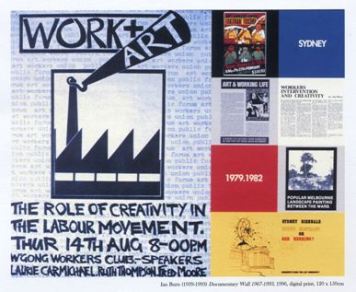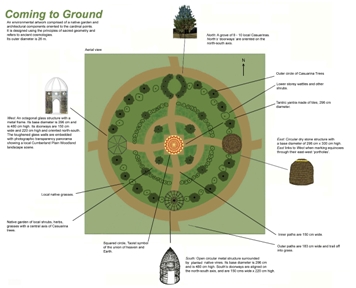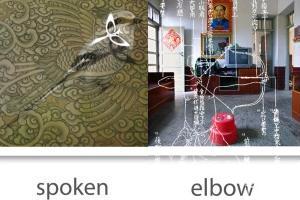2009 Exhibitions
- The Artist and the Social Order
- In Your Face
- Under Youth Challenge Australia: People and Places
- Coming to Ground
- Harmony Day Poster Competition
- David and Daniel
- Growing Up Green
- Elements
- The Spectacle Project
The Artist and the Social Order
Venue: UWS Art Gallery, Building AD, Werrington North, Penrith campus
Dates: 21 September 2009 - 27 November 2009
Open: Monday - Friday, 9.00 am - 5.00 pm
Throughout history, artists have chronicled and interpreted society, concerning themselves with the examination of social and political mores of the time. The exhibition, The Artist and the Social Order, focuses upon the influence of the artist, writer and unionist, Ian Burn.
Burn was a major figure in Conceptual Art in New York, organizing artists associations, publications and actions. He became affiliated with the Art and Language collective when he moved to London in 1964 and remained a part of the group when he moved to New York City in 1967. In 1977 Burn returned to Australia to teach at the University of Sydney. In the 1980s he began to work for the labour movement in Sydney in groundbreaking activities that combined cultural activities, industrial and political action.
A major component of the exhibition is Documentary Wall 1967 – 1993 which is comprised of seven panels designed by Julie Clarke, who worked closely with Ian Burn at Union Media Services in Sydney. It was created for the exhibition Artist's Think: The Late Works of Ian Burn, curated by Ann Stephen which surveyed the body of Burn's work and was co-hosted by Monash University Gallery and Queensland Art Gallery, opening in late July 1996.
The Documentary Wall reproduces book covers, posters and journals from the years 1967 to 1993, providing a visual record of a broader cultural history spanning local and international art works, artists organisations, publications and events. Burn's return to Sydney coincided with a period of renewed cultural activism, the emergence of the Artworkers' Union, The Australia Council, ACTU Art and Working Life program and the proliferation of local art magazines.
The exhibition also comprises of posters created at the Tin Sheds Art Workshop, University of Sydney. During the 1970s and 1980s, poster collectives or print media organizations were particularly prominent world wide. These organisations were fundamentally committed to ensuring access to control of information by people whose interests and concerns were under presented or not represented at all in the then dominant media forms of television, radio and newspaper.
The move toward a cultural democracy in both participation and access within the arts were major pillars of Australian Labor Party’s policy initiated by the Whitlam Government in the early 1970’s in order to develop and empower communities in Australia. Community Arts gained much political ground at this time, encouraging community involvement in creative activity was seen as a move toward cultural democracy.
Image above
Ian Burn (1939 - 1993)
Documentary wall 1967 - 1996
Digital print
120 x 150 cm
Reproduced courtesy of Avril Burn
In Your Face
Exhibition in September was In Your Face (PDF, 528Kb). This exhibition, produced by Year 7 - 10 students studying art at Elizabeth Macarthur High School, investigated portraiture through a variety of material, techniques and approaches. The opening was on Saturday 5 September at 2.00 pm. Exhibition continued until 2 October.
For more information, please see the Elizabeth Macarthur High School website.
The Exhibition in October was Serious Comics: an exhibition of Independent Australian Comics (PDF, 556Kb). Over its rich history, the medium of comics books has engaged in social commentary on contemporary issues and this exhibition continues that tradition. This exhibition features the work of independent comic book artists who have created uniquely Australian Superheros.
Under Youth Challenge Australia: People and Places
The exhibition in August was the photographic exhibition, Youth Challenge Australia: People and Places (PDF, 502Kb) which was opened on Saturday 1 August 2009.
Youth Challenge Australia is a non-profit, non-religious organisation that actively engages Australian volunteers in grass roots development work. In Central Australia, Vanuatu, India, Costa Rica, Guatemala, Mexico and Guyana, volunteers work in collaboration with local communities and partner organisations to assist the growth of sustainable and positive development.
The exhibition consists of photographs taken by the volunteers while in these communities and has been organised to support and celebrate their work.
For more information, please see the Youth Challenge website.
Coming to Ground
An Exhibition of works by Bette Mifsud
Venue: UWS Art Gallery, Building AD, Werrington North, Penrith campus
Dates: 18 June 2009 - 28 August 2009
Open: Monday - Friday, 9.00 am - 5.00 pm
Please join us at the opening on Thursday 18 June at 3.00 pm, to be opened by the Provost Penrith Campus and Pro Vice-Chancellor (Quality) Professor Geoff Scott.
The artist will give a floor talk at 4.00 pm - 5.00 pm in the lower gallery.
RSVP by Monday 15 June 2009 to Rosemary Hopkins at (02) 4620 3460 or r.hopkins@uws.edu.au
- Coming to Ground - Invitation (PDF, 606Kb)
- Coming to Ground - Brochure (PDF, 3MB)
» Take a Virtual Walk through the environmental artwork, Coming to Ground
Virtual Tour above
Bette Mifsud
Coming to Ground, 2009
Environmental Artwork
26 metre diameter
3D QTVR panorama by Dr Hilary Rhodes
Bette Mifsud - Artist Statement
This solo exhibition features the diorama and visualizations of a major environmental place-specific artwork entitled Coming to Ground within a body of related landscape artworks that led to its conception. The exhibition is designed as a chronological installation beginning at the left hand side entrance of the upper gallery level and concluding at the lower ground floor diorama.
The full-scale artwork is to be comprised of a native garden of local endangered Cumberland Plain Woodland vegetation, a tree grove and three architectural structures of stone, steel and glass oriented to the cardinal points, surrounded by interconnected circular paths and trees. The work’s proportions are determined by Golden Section geometry. Its ground plan is a mandala with a central yantra. Its ground plan is a mandala whose circular footprint has diameter of 26 metres.
Coming to Ground began its long incubation in my early life as a first generation Maltese-Australian while working family market gardens on traditional Dharug land in North Western Sydney between 1963-1981, followed by a 25-year visual art practice. Aspects of it appeared in different artworks over time, and converged during two years’ intensive practice-led creative doctorate research at the University of Western Sydney.
It is informed by research in climate change, eco-feminism, eco-philosophy, eco-psychology, ancient cosmologies, sacred architecture, connective aesthetics and contemporary environmental art, local native botany, local indigenous heritage and non-indigenous history. The research focused on the psychological source of anthropogenic climate change and biosphere degradation, and funnelled into this artistic contribution to their remedy.
Ecopsychologists see the human psyche as an integral part of the living world. Its state is mirrored in the state of the ecosphere. Contemporary unsustainable urban landscapes largely reflect a dismembering industrialized consumer consciousness. By contrast, many ancient traditional cultural ecologies are necessarily holistic and sustainable. Coming to Ground is intended as a reconstructive environmental artwork representing a return of universal holistic cosmological knowledge and unifying symbolism to the Western Sydney multicultural landscape.
The mandala, while widely recognised as an Indian cultural form, is a universal idea, known by many names and embodied in numerous spiritual philosophies. It functions as an integrative device by means of transformation of consciousness (or layers of meaning). From the chaotic outer to the harmonised inner sanctum of the mandala lies a journey toward greater integration and integrity. However, this journey requires crossing a bridge between poetry and pragmatism; philosophy and practice; heaven and earth, in a yin-yang style embrace. This entails "the understanding of the inseparability of knowledge and action"; of heart and mind. (Dellios, 1996: 1-20)
The specific reconstructive purposes of this artwork are to: acknowledge the history that formed Western Sydney’s multicultural geography; symbolically embody a gathering of local diverse cultures; encourage the development of a holistic ecological consciousness in the region; create a living metaphor of positive transformations over time; present connections between, and integration of, human and non-human creativity by way of the native garden; offer a welcoming landmark and a contemplative sanctuary that is integrated within its surroundings; return endangered native woodland vegetation to the Cumberland Plain.
![]()
The title, Coming to Ground, originated in Martin Thomas’s room note for the exhibition of my landscape mural, Fugitive Ground (2002):
In crafting a tableau from frozen photographic moments, from scenes that we can behold but never possess, the artist refers to an unresolved history of territorial seizure, expressing the disconnectedness of a migrant culture which has yet to come to ground.
This ‘migrant’ disconnection is revealed in a number of artworks, including my Homage to 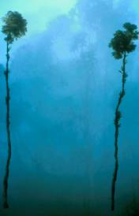 Caspar David Friedrich (2005), a digital montage of my Katoomba garden on a misty day and two trees from the painting The Avenue Middelharnis (1689) by Meyndert Hobbema. The two European trees were severed from their original culture and hover above the living native Australian landscape.
Caspar David Friedrich (2005), a digital montage of my Katoomba garden on a misty day and two trees from the painting The Avenue Middelharnis (1689) by Meyndert Hobbema. The two European trees were severed from their original culture and hover above the living native Australian landscape.
We culture the landscape and the landscape cultures us. A garden is more than a place to grow food or flowers. It is an ageless communion with land, soil, elements, seasons and cosmos.
In the native garden we can cultivate a sustainable grounding communion with indigenous ecologies.
For more information, please see the Bette Mifsud website.
Bette Mifsud
May 2009
Images above
Bette Mifsud
Fugitive Ground, 2002
Photo-digital mural on paper
12.4 x 0.6 m
Bette Mifsud
Homage to Caspar David Friedrich, 2005
Print on canvas
70 x 120cm
Thomas, M, 2004 'A Spatial Tapestry', Room Note for Bette Mifsud’s Fugitive Ground, Penrith Regional Gallery and Lewers’ Bequest.
Dellios, R, 1996 'Mandalas of Security', The Culture Mandala, Bulletin of the Centre for East-West Cultural and Economic Studies, Vol. 2, No. 1.
Harmony Day Poster Competition
The exhibition in July was 2009 Harmony Day Poster Competition Exhibition (PDF, 534Kb), an initiative of Moving Forward Together Inc., a project of the Alfred Dreyfus Unit of B'nai B'rith.
The mission of the organisers of this exhibition is to promote acceptance, respect, harmony 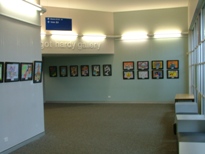
The exhibition was opened by The Hon. Laurie Ferguson MP, Parliamentary Secretary for Multicultural Affairs and Settlement Services on Thursday 2 July 2009 at 11.00 am - 12.00 pm.
David and Daniel
The exhibition in June at the Margot Hardy Gallery was David and Daniel (PDF, 459Kb), an art exhibition by David Yeh and Daniel Kim. UWS invites you to the opening on Saturday 13 June 2009 from 2.00 pm to 4.00 pm.
Daniel Kim is an artist based in Kings Langley with special needs. He has always shown great interest in painting and drawing since childhood. With the guidance from Rowland Hassall School and Access Art Consultant, Cassandra Hard, he has been able to join various studio projects and exhibitions. Daniel is currently enrolled at TAFE, studying Foundation Painting and Drawing. He continues to express his emotions and his view of the world through art. As a person, he is quiet and 'cheeky'—and brings a gentle and warm presence to others around him.
Daniel draws most of his inspiration to make images from real life. He has mostly painted in the genres of Still Life and Landscape, but recently he has started exploring portraiture. This exhibition contains several landscapes and still-life's, but also contains a recent project whereby Daniel has painted his family members from photographs.
David Yeh is a Glenorie based artist with special needs. David has always been interested in art since childhood, but has been practicing art more seriously in the last six years, working with Access Art Consultant, Cassandra Hard.
Within his art practice, David is interested in abstraction and pattern making—exploring elements such as colour, shape, tone and texture. He has developed a highly expressive style, applying his drawings and paintings with energetic marks and brush strokes. David also enjoys painting people. He has a 'warts-and-all' approach to his sitter, desiring to paint everything he sees. A series of portraits has been included in this exhibition.
David's most recent project has been a series of designs based on Eastern pattern making. His interpretation of Moghul design has resulted in a beautiful set of flowers and leaves, carefully drawn in watercolour pencil.
Growing Up Green
The exhibition was opened by Mr Tony Steward MP, Member for Bankstown and children from George Hall Public School will perform a choral piece. The exhibition is a compilation of winning and highly commended artworks from last year's Western Sydney Environment Calendar Art Competition which was opened to all NSW public school children from the region.
Elements
An Exhibition with works by Sally Tsoutas, Megan Sprague and Marilyn Walters.
Venue: UWS Art Gallery, Building AD, Werrington North, Penrith campus
Dates: 23 March 2009 - 29 May 2009
Open: Monday - Friday, 9.00 am - 5.00 pm
- Elements Exhibition Invitation (PDF, 674Kb)
Please join us for the artist talks on Saturday 9 May 2009 from 2.00 pm. Please RSVP by Wednesday 5 May 2009 to (02) 4620 3460 or email r.hopkins@uws.edu.au
This exhibition is a response to the concept of the elements, Earth, Water, Air, Fire and Aether, which dates back to pre-Socrates times and persisted throughout the Middle Ages and Renaissance, deeply influencing European thought and culture. This concept of essentially the same five elements, are similarly found in ancient India, China and Japan. The artists, Megan Sprague, Sally Tsoutas and Marilyn Walters explore the representation of these elements within contemporary culture as well as the interaction of human communities with them in their everyday material lives.
Megan Sprague's installation, Atlas Shrugged is comprised of 4000 human figures creating a map of the earths' land masses, emphasizing that humans are dependent upon it and each other for their own physical survival. The work is deliberately a floor piece, in a mandala like configuration to be viewed from above. In spiritual traditions, mandalas are employed for focusing attention within meditation practices, as well as establishing a sacred space. Sprague's work encourages us to contemplate and explore the being with community rather than thinking first from that of an individual.
Sally Tsoutas’, Flux images explore the four basic elements , earth, fire, water, air at a subatomic level. The idea captured within the work is that objects are not separate from one another or the whole, but are an accumulation of variously arranged subatomic particles, arranged at different densities and vibrating at different frequencies. Within her Time series, she has focused upon time and the way the four elements work upon each other within a single moment.
Marilyn Walters’ works are a celebration of water as the source of life arising from the pre Socrates idea of water as the first principle, the essential substance from which all life originated and to which it ultimately returns.
Images above (left to right):
Sally Tsoutas
Fire by Night, Nevertire, 2009
Photograph
Megan Sprague
Atlas Shrugged, 2008
Installation
Marilyn Walters
Reef 2 (detail), 2008
Oil on canvas
Megan Sprague
Atlas Shrugged, 2008, 4000 plaster figurines, DVD projection 5 min looped
Atlas Shrugged is one of a series of recent works that reflects my shift in thinking about the relationship of the individual to community. The consequence of the finished work, questions not only our relationship to each other but in addition our relationship with the earth.
It was Jean-Luc Nancy that said to think the individual, the singular, first, before that of community is to think one’s existence in terms of absolutes, theoretical philosophical extremes, as atomized beings. Ultimately he believed that there is no meaning if meaning is not shared. An atomistic idea of an individual being, completely detached from its environment, oscillating in its own space and time, devoid and disconnected from all other atoms, individuals or its environment. In absolute terms, the individual atom shows us its meaninglessness. It has no capacity to be toward the other, it can rather only be unto itself. Nancy’s thinking does not diminish the relevance of the individual; rather the shift of focus is from thinking the individual first, to a different point of departure, the being-with of community.
This is the departure point I explore, the being-with of community rather than to think first from that of the individual. Four thousand individual cast figurines are juxtaposed against a digital projection of an individual, the artist, as Atlas the Greek Titan who holds the weight of the world on his shoulders. This work contrasts the individuality of the artist with the mass of the people. By drawing attention to the artist, I question the complicity I myself, an individual, and an artist play in the perpetuation of individualism.
The title of the work is borrowed from Ayn Rand’s book of the same title. In her book Rand promotes the idea that the accomplishments of one man should take primacy over the needs of the collective, and that mans primary goal is the pursuit of happiness. 'My philosophy, in essence, is the concept of man as a heroic being, with his own happiness as the moral purpose of his life, with productive achievement as his noblest activity, and reason as his only absolute'. Rands text provided the platform for her philosophical work on Objectivism. The principles underlining Objectivism i.e. economic liberalism or laissez-fair capitalism gained a lot of currency both politically and economically in the 1950’s and 60’s. Today it is once again relevant. The reference to Rand is all the more relevant as it was Rand that characterized her philosophy as 'a philosophy for living on earth,' grounded in reality, and aimed at defining man's nature and the nature of the world in which he lives.
Artist Statement 2008
Sally Tsoutas
Flux
Sally Tsoutas’ bank of four images entitled Flux is an exploration of the four basic elements earth, fire, water, air, at a subatomic level.
The artist is passionate about unified theory, and research into the connectivity of the universe. The idea that objects are not separate from one another or the whole, but are an accumulation of variously arranged subatomic particles, arranged at different densities and vibrating at different frequencies, fascinates her. Tsoutas has used grain and blur, to visually explore these four basic elements that are fundamental to all sciences, in an effort to reflect upon the notion that the elements are different types of energy, in a constant state of flux and interaction with one another.
Tsoutas takes a great interest in the work of modern science’s theoretical physicists and their efforts to shift scientific paradigm to better answer the mysteries of the unempirical. The greatest paradigm shift of all it seems though, is the realisation that some phenomena cannot be empirically proven, and yet can still exist, and that eastern science has understood this anomaly for centuries. Through her images Tsoutas celebrates the simplicity of the eastern perspective, that the elements are phases, or movements, describing relationship between phenomena.
Artist Statement March 2009
Time
Sally Tsoutas’ series of eight photographs entitled Time is a meditation on the residue of the moments of life. Tsoutas has been interested in the science of our existence for a long while, particularly the polarity between empirically proven phenomena and that which appears to exist but is not yet proven by western scientific enquiry. The study of energy, the elements and the nature of change intrigues her.
Tsoutas’ choice of tool for expression is the camera, which is an apparatus capable of provoking reaction and thought by capturing nothing but light upon a subject at a particular moment in time. The subject exists or existed, as did the moment, which itself passes, but the photographic impression of it is just light, far subtler than the subject itself.
Subtler still however, is the alchemy the photographer experiences at the instant the shutter is released at the chosen moment. The chaos and frenetic action that so permeates our busy working lives was the catalyst for Tsoutas to begin to notice and appreciate the beauty and renewal in the seemingly mundane, as she traversed the backwaters of our existence en route from A to B.
Spilled coffee in the corner of a dirty garage, a shopping trolley swallowed by water, and a rusty stain on an old weathered wall.
In an effort to slow it down, Tsoutas has focused on time, and the way the four elements earth, fire, water and air, work upon each other within it. This has allowed her to touch on the fifth element, which Plato called Aether, or ‘Quintessence.’ Non existent for modern science, but very much a part of ancient Greek, Indian and Chinese science and thought, ether is nothing and infinite, has no qualities (neither hot, wet nor dry), is incapable of change, and is subtler than light. Ether is a place of rest, and the domain of the higher soul.
The photographer knows of the cathartic sweetness that is felt, at the right moment, when all the elements fall into place, and a photograph is made. The paradox is that the act of preserving the moment, printing it, heralding it in a book or on a wall, in order to reflect and respond to it, denies this truth. The moment of clarity and the feeling of expansion has passed, and the brush with Ether becomes bound by thought. All that remains is the residue of the moment, which even though it is limited, has a beauty and purpose of its own.
This series celebrates pure observation, a universal action which can help to transcend our earthly manifestation and show us that which is without boundary; a purity for which humanity yearns and supposedly possesses, but seems only to be able to glimpse.
Artist Statement March 2009
Marilyn Walters
First Principle
My work is a celebration of water as the source of life arising from the pre Socratic idea of water as the First Principle, the essential substance from which all life originates and to which it ultimately returns. My paintings explore the representation of water in ancient and in contemporary cultures as well as the interaction of human communities with water in their material and spiritual lives. From the strip of white wake slashed across the sapphire harbour to the wonder of life below the water’s shimmering face; from the passage of the moon across a languid pool to the incessantly swirling waters of the Grand Canal, from the impenetrable curtain of a Sydney rainstorm to the dancing light that teases the grassy surface of the bay and pool, I am reminded of the constancy and the fragility of water.
I see in the water-like patterns carved in the stone of ancient Celtic tombs, as in the Nympheas of Monet and in Gaudi’s wondrous flowing mosaics, or indeed, in David Hockney’s playful splashes, an expression of the sacred, the mysterious, the eternal, the essential.
Artist Statement 2008
The Spectacle Project
An Exhibition by David Cubby
Venue: UWS Art Gallery, Building AD, Werrington North, Penrith campus
Dates: 22 December 2008 - 27 February 2009
Open: Monday - Friday, 9.00 am - 5.00 pm
- The Spectacle Project Invitation (PDF, 639Kb)
Please join us for an artist talk on Saturday 31 January 2008 from 2.00 pm. Please RSVP by Tuesday 27 January 2009 to (02) 4620 3460 or email r.hopkins@uws.edu.au
David Cubby's current exhibition is concerned with the history of optics, through both text and image.
The exhibition is comprised of three short films, Optic Lingo, Drown Optics and Optical Scream, as well as digital prints which are stills from these films.
'Prevalent within western culture, 'seeing' becomes a euphemism 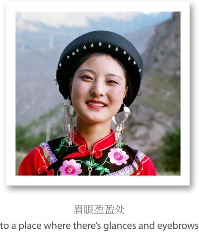 for 'understanding' and it is dangerous. Photo media generally provides a dominant aesthetic, affecting thought, language and culture. Each work within 'The Spectacle Project' is intentionally hypnotic, subverting mass psychosis distanced from reality, induced by filtered viewing through optical-electronic time and space.'
for 'understanding' and it is dangerous. Photo media generally provides a dominant aesthetic, affecting thought, language and culture. Each work within 'The Spectacle Project' is intentionally hypnotic, subverting mass psychosis distanced from reality, induced by filtered viewing through optical-electronic time and space.'
Dave Cubby
December 2008
Images above are stills from the short film Optic Lingo, 2008. Reproduced courtesy of the artist, David Cubby.
Mobile options:

